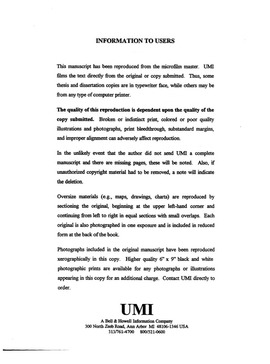| dc.contributor.advisor | Kline, Ronald, | en_US |
| dc.contributor.author | Liqiang, Jiang. | en_US |
| dc.date.accessioned | 2013-08-16T12:30:18Z | |
| dc.date.available | 2013-08-16T12:30:18Z | |
| dc.date.issued | 1998 | en_US |
| dc.identifier.uri | https://hdl.handle.net/11244/5711 | |
| dc.description.abstract | Another effort in this study is devoted to employing Rayleigh waves with a line-focused acoustic microscope to characterize the through-thickness residual stress distribution. Assuming the principal strain directions are known and strains are polynomially distributed with depth while uniform in the other directions, equations for the Rayleigh wave velocity change versus the initial static stress are derived with a first order perturbation approach. This information can be used to reconstruct synthetic in-plane stress distributions from frequency dependent Rayleigh wave velocity data. | en_US |
| dc.description.abstract | As a promising tool to characterize residual stresses in engineering structural components, acoustoelasticity has been the subject of a great deal of research over the past forty years. Although considerable achievements have been made, most approaches to ultrasonic stress analysis are limited in their utility due to their reliance on contact shear wave transducers which preclude the ability of scanning large areas, their inability to resolve the dependence of stress on depth, and their difficulties in taking accurate time delay measurements, resulting from coupling problems and the very small acoustoelastic effect observed for most practical materials. Recently, Drescher-Krasicka conducted a series of experiments to illustrate how scanning acoustic microscopy can be used to characterize applied and residual stresses by monitoring the peak amplitudes of the resultant signals of shear waves produced by mode conversion. In this study, a theoretical study and numerical simulations are performed to provide a quantitative correlation with the experiment results so as to lay a theoretical foundation and enhance the understanding for this new scanning technique. Based on the theory of finite deformations and the equation of motion, Christoffel equations in the presence of strains are derived. They are solved with first order perturbation theory to determine the two quasi-shear wave velocities. The acoustic microscope lens is modeled as launching a strong axisymmetric longitudinal lobe at oblique incidence. Two shear waves polarized in the directions of the in-plane principal stress axes will be simultaneously generated by mode conversion at the water-specimen interface. Due to the constructive-destructive interference between the signals of the shear waves, the amplitude of the combined signal of the acoustic microscope turns out to be very sensitive to small changes in acoustic velocity produced by local stresses. The numerical simulation shows good agreement with the experimental results for a diametrically loaded disk case. | en_US |
| dc.format.extent | xi, 133 leaves : | en_US |
| dc.subject | Engineering, Mechanical. | en_US |
| dc.subject | Residual stresses. | en_US |
| dc.subject | Engineering, Aerospace. | en_US |
| dc.subject | Physics, Acoustics. | en_US |
| dc.subject | Acoustic microscopy. | en_US |
| dc.title | Advances in acoustic stress characterization. | en_US |
| dc.type | Thesis | en_US |
| dc.thesis.degree | Ph.D. | en_US |
| dc.thesis.degreeDiscipline | School of Aerospace and Mechanical Engineering | en_US |
| dc.note | Source: Dissertation Abstracts International, Volume: 59-09, Section: B, page: 4944. | en_US |
| dc.note | Major Professor: Ronald Kline. | en_US |
| ou.identifier | (UMI)AAI9905627 | en_US |
| ou.group | College of Engineering::School of Aerospace and Mechanical Engineering | |
